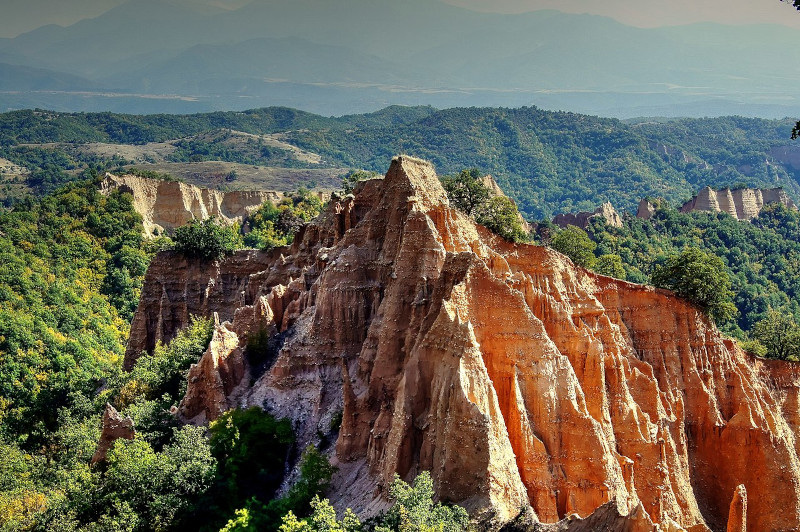
Melnik Earth Pyramids Facts
- These breathtaking formations most consistently go by the very distinctive common name of the Melnik Earth Pyramids in the region they’re found in. They do have several other general titles, though. These epithets simply represent variations of the major term, however.
- These titles include such distinctive designations as Melnik Sand Pyramids, Melnik Sandstone Pyramids, Melnik Hoodoos, and the Melnik Rock Pyramids. Yet, regardless of which one of these tags one chooses to use, they represent truly remarkable geological formations.
- No known evidence records who first discovered these amazing constructions of Nature. Though it’s possible ancient man knew of their existence, it’s only known for certain that local inhabitants of the region have been aware of their presence for several centuries.
- The incredible uniqueness of the amazing Melnik Earth Pyramids merits multiple distinctions. Among those stands the fact that it’s now officially designated as an architectural reserve. It’s also formally listed as a natural landmark by the government of the country it’s in.
- Its stunning beauty does come with something of a price, however. Due to its obvious visual appeal, it’s become a leading tourist draw in the region. Receiving visitors year-round, local officials make great efforts to preserve the integrity of the site from man’s depredations.
Related Articles
Melnik Earth Pyramids Physical Description
The mesmerizing Melnik Earth Pyramids never fail to capture the imagination and inspire awe in those individuals fortunate enough to visit them. Unlike some natural features, though, these marvels equally do so due to both their remarkable beauty and respectable physical dimensions.
These amazing natural structures developed as generally cone-shaped in form, with wider bases tapering to strongly pointed tips. Their symmetry and smooth curves also comes in an incredibly diverse range of shapes and exact forms. This tendency also serves to make them truly striking.
These marvels of geology also vary significantly in terms of size. Many of their number reach heights measuring around 10 – 16 ft (3 – 5m). The majority, however, average roughly 33 ft (10 m) tall. Yet, some of these true masterpieces of Nature soar to heights totaling as much as 330 ft (100 m).
These constructs have an amazing design, yet surprisingly simple composition. That’s because they’re mainly composed of the mineral sandstone, with layers of conglomerate and clay added. The softer layers obviously erode more quickly, leaving behind the harder rock to form the capstones.
Yet, it’s the breathtaking colors of the aptly-named Melnik Earth Pyramids that usually garner the most attention. Set against a backdrop of rolling hills and verdant countryside, these only enhance their aesthetic appeal. The surrounding landscape contributes to the overall sense of natural beauty.
Here, in this remarkable location, Nature worked to create a legitimate natural wonder. Using its minerals and the passage of time, it laid its mighty work. The pyramids exhibit various shades of brown, red, and orange, depending on the mineral content of the rock and the lighting conditions.
Melnik Earth Pyramids Location, Formation, and Ecology
The fabulous Melnik Earth Pyramids formed in a region of the globe already well known for its incredible abundance of natural wonders. The location of that area of the world thus likely won’t surprise many of you. That’s true since this amazing formation resides in the confines of Europe.
There, the marvel of geological processes lies inside the national boundaries of the country of Bulgaria. Further situated within the southwestern section of the beautiful country, its position places the group at the foothills of a local mountain range, forming part of the Balkan Peninsula.
These astoundinf formtions also form part of the valley of the Melnishka River, itself actually a left tributary of the Struma river. These awesome rock formations lie roughly 112 mi (180 km) south of the national capital Sofia, and 40.4 mi (65 km south) of the regional center Blagoevgrad.
Their formation also began in ages long past. Between roughly 5 -3 million years ago, a lake present at the time deposited sediments. The lower layer is over 330 ft (100 m) deep and composed of lightly soldered grey to yellowish sands and gravels made up mainly of quartz grains and clay strata.
The layer situated just above, however, of similar depth, forms most of the pyramids and was made by lightly soldered or unsoldered rust and reddish conglomerate. That highly distinctive color forms due to the presence of iron hydroxides produced by the decomposition of certain minerals.
The process of formation as the site’s known today began with the gradual erosion of the softer rock by wind and water. This action left behind pillars or columns of harder rock. Over time, these gradually eroded, but the larger boulders on top protected the softer rock directly beneath.
Remarkably, the otherwordly splendor known as the Melnik Earth Pyramids also play host to a thriving ecosystem. Most, in fact, have a dense covering of lush vegetation, and a wide variety of habitat types. The amazing area also has a strong Mediterranean climate influencing this, as well.
Deciduous forests appear in numerous places, along with countless species of shrubs and grasses. A surprising number of small animals also call these marvels home, too. A total of 113 known bird species live in or make use of the location, as well as foxes, rodents, deer, and other such.
Features Sharing Its Region
Check out our other articles on 3 Stunning Snakes of Africa, Rice’s Whale, Deception Island, Mountain Ebony, Rose’s Ghost Frog, Japanese Beetle, Weka, Orinoco Crocodile
